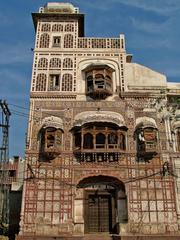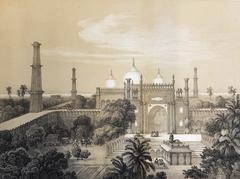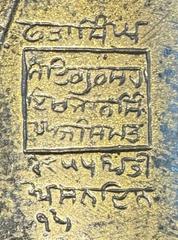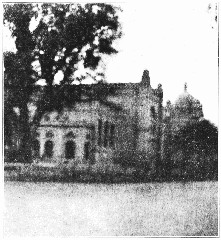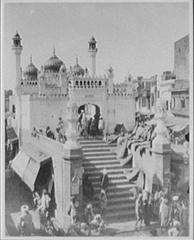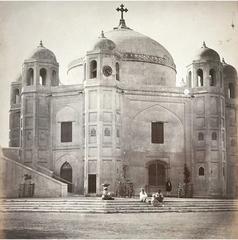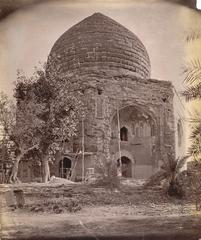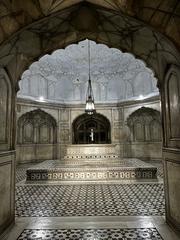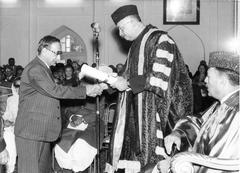Kashmiri Gate Lahore: Visiting Hours, Tickets, and Historical Significance
Date: 15/06/2025
Introduction
Kashmiri Gate, one of the thirteen original entrances to Lahore’s legendary Walled City, stands as a living testament to the city’s Mughal heritage and vibrant contemporary culture. Constructed during Emperor Akbar’s reign in the late 16th century, the gate has served as a vital northern entryway, connecting Lahore to the scenic Kashmir Valley and facilitating centuries of trade, migration, and cultural exchange. Today, Kashmiri Gate welcomes visitors to a rich urban landscape, blending centuries-old architecture, bustling markets, and ongoing conservation efforts that protect its historic character.
This comprehensive guide covers everything you need to know about Kashmiri Gate: its historical background, architectural features, significance in Lahore’s social fabric, up-to-date visiting hours, ticket information, accessibility, travel tips, and highlights from the recent 2023–2024 conservation project. Whether you are a history enthusiast, cultural explorer, or first-time visitor, this article will help you experience one of Lahore’s most evocative heritage sites to the fullest.
For further exploration, see official resources from the Walled City of Lahore Authority, detailed guides such as El Momento on Lahore’s 13 gates, and visitor insights from Pakistan Tours Guide.
Historical Background
Origins and Naming
Kashmiri Gate’s name reflects its historical orientation toward Kashmir, serving as a vital gateway for traders and travelers journeying between Lahore and the northern regions (Guide to Pakistan). The construction of the city’s fortified walls and gates, including Kashmiri Gate, is attributed to Mughal Emperor Akbar’s urban development initiatives in the late 16th century. The gate functioned both as a defensive structure and as a regulated checkpoint, controlling the movement of people and goods into Lahore (Slideshare: Lahore Gates).
Historical Significance
Over the centuries, Kashmiri Gate has witnessed the rise and fall of various empires—Mughal, Sikh, and British—each leaving their imprint on the structure and surrounding neighborhoods. During the Mughal era, the gate was a hub of commercial and social activity, and under Sikh and later British rule, its strategic and administrative roles continued. Despite modifications and partial demolitions during the colonial period, Kashmiri Gate has retained its prominence as a symbol of Lahore’s storied history (El Momento).
Architectural Features
Structural Design
Kashmiri Gate exemplifies Mughal architectural style, constructed primarily from red sandstone and brick. Its pointed arch, robust buttressed walls, and once-imposing wooden doors reinforced with iron studs highlight both its defensive and ceremonial functions. Though some original features have weathered over time, visitors can still appreciate the gate’s essential form and grandeur (El Momento).
Decorative Elements
Mughal artisans adorned the gate with intricate geometric patterns, floral motifs, and decorative tilework. While time and urban development have obscured some of these embellishments, restoration efforts continue to recover and highlight these historical details.
Urban Integration and Cultural Role
Kashmiri Gate is not an isolated monument but is deeply woven into Lahore’s living urban fabric. Beyond the gate, the Kashmiri Bazaar thrives as a vibrant hub of textile and traditional goods, reflecting the area’s enduring commercial vitality (Pakpedia). The surrounding neighborhood features historic havelis, religious institutions, and educational sites, all contributing to the gate’s role as a focal point of community life.
2023–2024 Conservation Project
Restoration Highlights
The recent conservation project, led by the Walled City of Lahore Authority (WCLA), focused on restoring Kashmiri Gate’s architectural integrity and enhancing visitor experience. The initiative included:
- Structural repairs using Mughal-era techniques and materials.
- Restoration of frescoes and decorative linings to revive original artistry.
- Reinforcement of walls and roof for long-term stability.
- Repair and reopening of original doors for historical authenticity.
- Removal of encroachments and unauthorized commercial structures to restore the gate’s visibility.
- Improved utilities and lighting for visitor comfort and nighttime ambiance.
The project involved engagement with local communities and collaboration with heritage organizations to ensure sensitive and sustainable preservation (Walled City of Lahore Authority).
Visiting Kashmiri Gate: Essential Information
Visiting Hours
- Typical visiting hours: 9:00 AM – 7:00 PM daily.
- Conservation project hours: 9:00 AM – 6:00 PM, with evening illumination enhancing the experience.
- Note: Hours may vary during public holidays and festivals. Early mornings and late afternoons offer the best visiting conditions.
Tickets and Entry Fees
- Entry to Kashmiri Gate is free for all visitors.
- Guided heritage walks by WCLA may require advance booking and a nominal fee for enhanced experiences.
Accessibility
- The area features narrow, historic streets; accessibility for wheelchairs or those with mobility challenges is limited, though restoration has improved pathways.
- Comfortable walking shoes and preparedness for uneven surfaces are recommended.
Guided Tours
- Heritage walks and guided tours are available through WCLA and reputable tour operators. These tours often include nearby attractions such as the Wazir Khan Mosque and Azam Cloth Market.
Nearby Attractions
- Kashmiri Bazaar: Renowned for textiles, children’s shoes, and traditional crafts.
- Wazir Khan Mosque: An architectural masterpiece within walking distance.
- Azam Cloth Market: One of Asia’s largest textile markets.
- Delhi Gate and Bhati Gate: Other restored city gates offering unique insights into Lahore’s history.
- Bangla Ayub Shah: A historic haveli within the Kashmiri Gate area.
Cultural and Social Significance
Kashmiri Gate remains a vibrant center of Lahore’s urban life, hosting markets, festivals, and public events. It is a microcosm of the city’s cultural diversity, where Mughal, Sikh, and colonial legacies intersect with contemporary commerce and community traditions. The gate and its surroundings are often at the heart of celebrations such as Basant and religious processions, reinforcing its role as a living heritage landmark (Locally Lahore).
Visitor Tips
- Best time to visit: October to February for mild weather.
- Transport: Best accessed by rickshaw, taxi, or on foot due to narrow streets. Lahore Metrobus stops nearby.
- Safety: Exercise standard precautions; keep valuables secure and respect local customs.
- Photography: Allowed, but ask permission when photographing people.
- Facilities: Limited public restrooms; bring water, sanitizer, and a navigation app.
- Food: Enjoy street food in the bazaar; choose busy stalls for freshness.
Frequently Asked Questions (FAQ)
Q: What are the visiting hours for Kashmiri Gate?
A: Typically 9:00 AM to 7:00 PM; conservation project hours are 9:00 AM to 6:00 PM.
Q: Is there an entry fee?
A: No, entry to Kashmiri Gate is free.
Q: Are guided tours available?
A: Yes, through the Walled City of Lahore Authority and local operators.
Q: Is Kashmiri Gate wheelchair accessible?
A: Accessibility is limited, but restoration efforts have improved pathways.
Q: What are the main nearby attractions?
A: Kashmiri Bazaar, Wazir Khan Mosque, Azam Cloth Market, Delhi Gate, Bhati Gate, and Bangla Ayub Shah.
Preservation and Responsible Tourism
Visitors play a vital role in conserving Kashmiri Gate by respecting the site, minimizing litter, and supporting local businesses. The Walled City of Lahore Authority and local NGOs actively promote responsible tourism and ongoing restoration projects. Participation in heritage walks and cultural events contributes to sustaining the gate’s legacy (Vacay Adviser).
Visual and Interactive Resources
- High-quality images of Kashmiri Gate’s façade and bazaars with descriptive alt text are available on the WCLA website.
- Interactive maps and virtual tours are recommended for pre-visit planning.
Recommendations for a Memorable Visit
- Allocate at least half a day to fully explore the gate, bazaar, and nearby historical sites.
- Engage with local shopkeepers—they often share fascinating stories and historical insights.
- Try authentic Lahori street food from reputable stalls.
- Support heritage conservation by joining guided tours and respecting the site.
Conclusion
Kashmiri Gate stands as a remarkable emblem of Lahore’s multi-layered history, architectural splendor, and enduring cultural vibrancy. Thanks to comprehensive conservation efforts, it now offers an enhanced and accessible experience for visitors eager to connect with the city’s soul. Plan your visit to Kashmiri Gate for an immersive journey through time—exploring markets, monuments, and the living traditions of one of South Asia’s most storied cities.
For deeper engagement, download the Audiala app for curated walking tours and up-to-date information. Follow the Walled City of Lahore Authority and explore additional resources for a richer exploration of Lahore’s heritage.
Sources and Further Information
- El Momento’s guide to the 13 gates of Lahore
- Pakistan Tours Guide: 13 Gates of Lahore
- Walled City of Lahore Authority – Official Site
- Pakistan Tourism Portal: Kashmiri Gate
- Pakpedia: Gates of Lahore
- Locally Lahore: Gates of Lahore
- Vacay Adviser: Walled City of Lahore
- Crayon.pk: Famous Gates of Lahore
